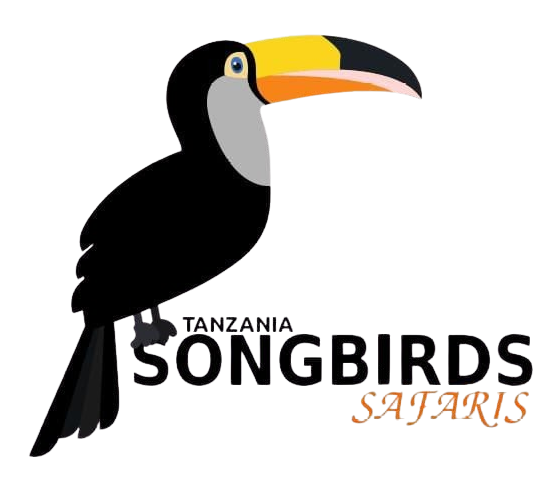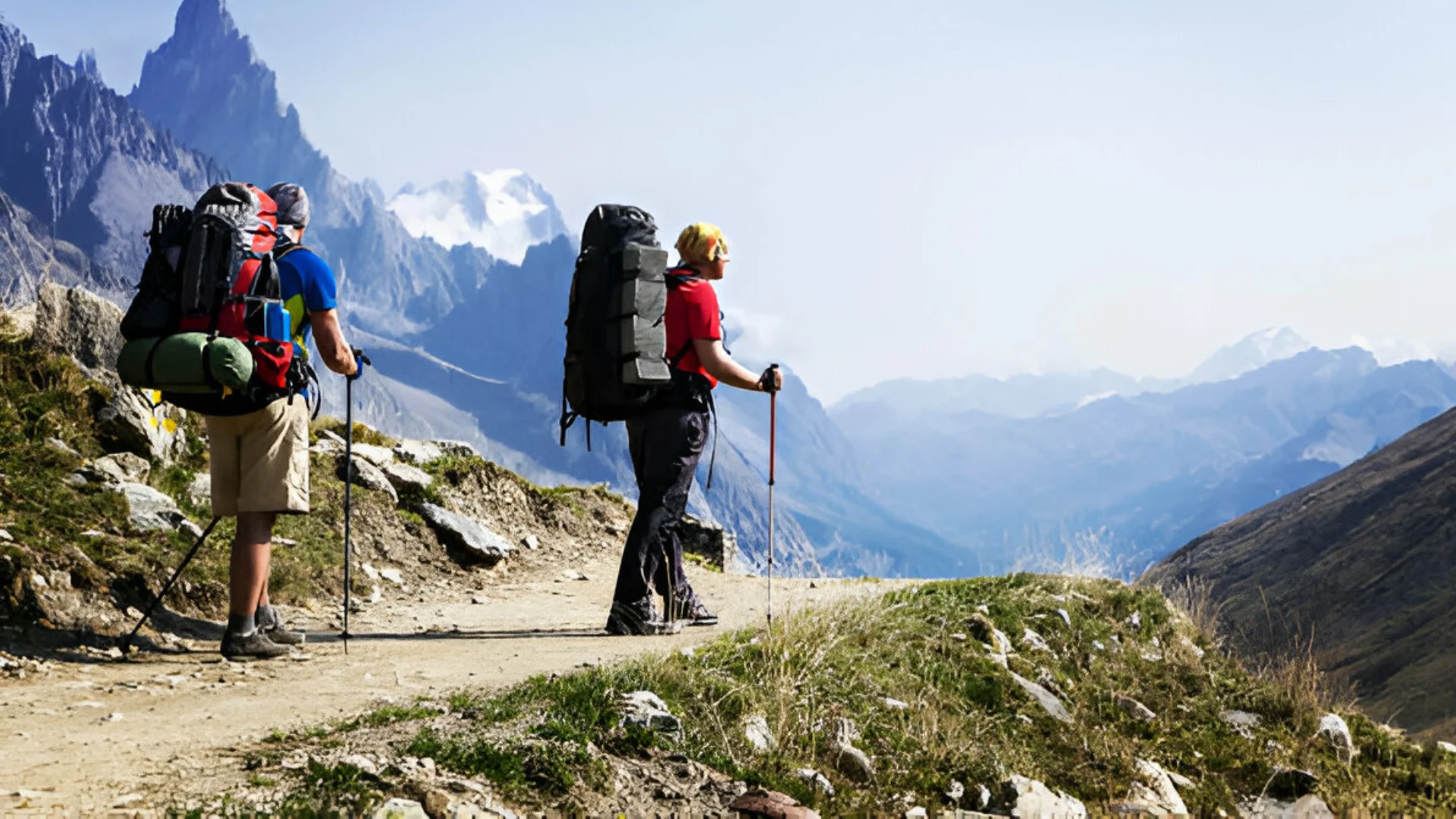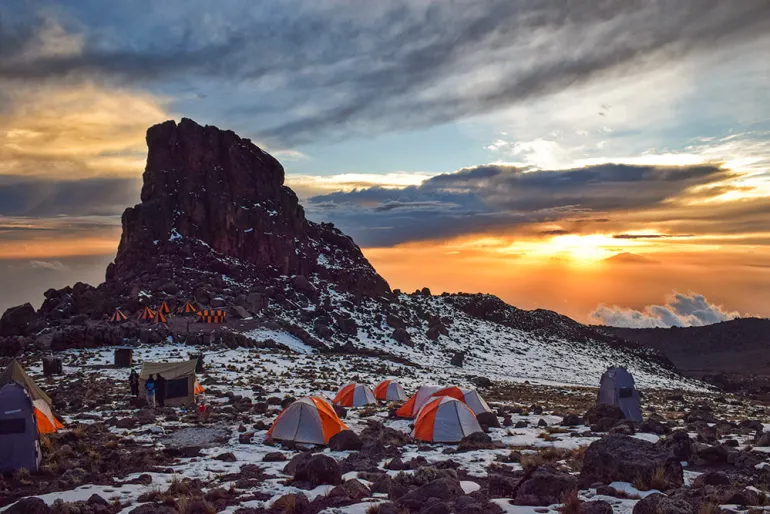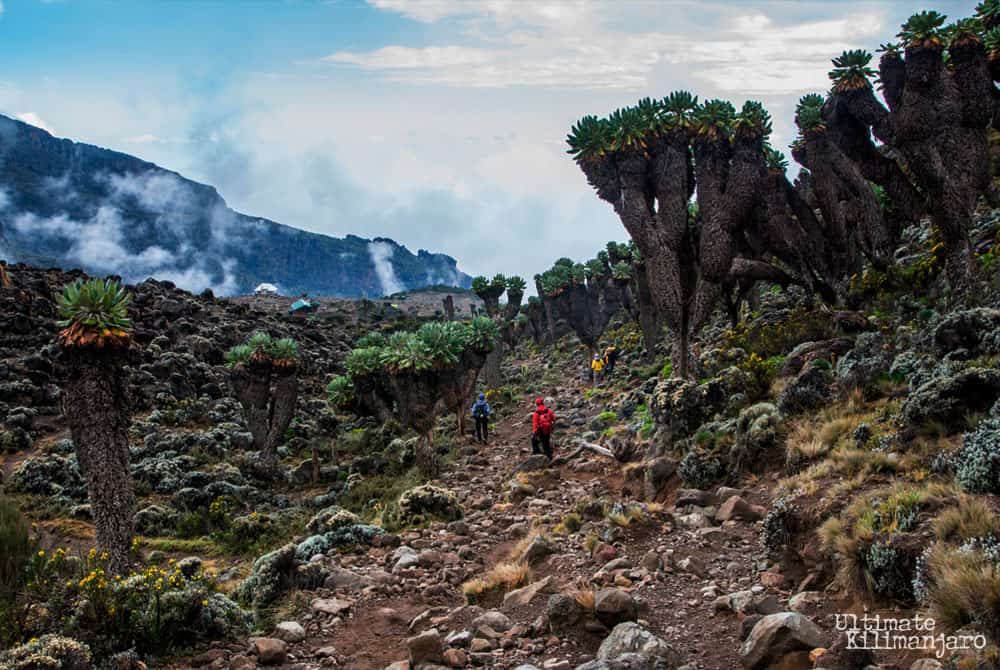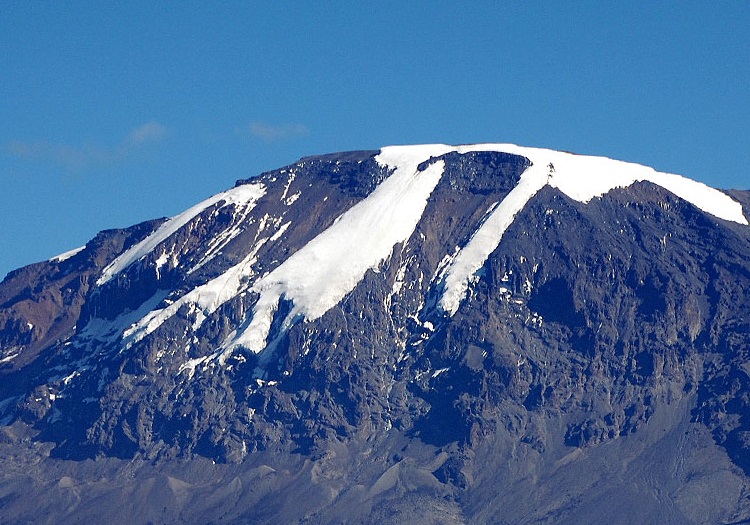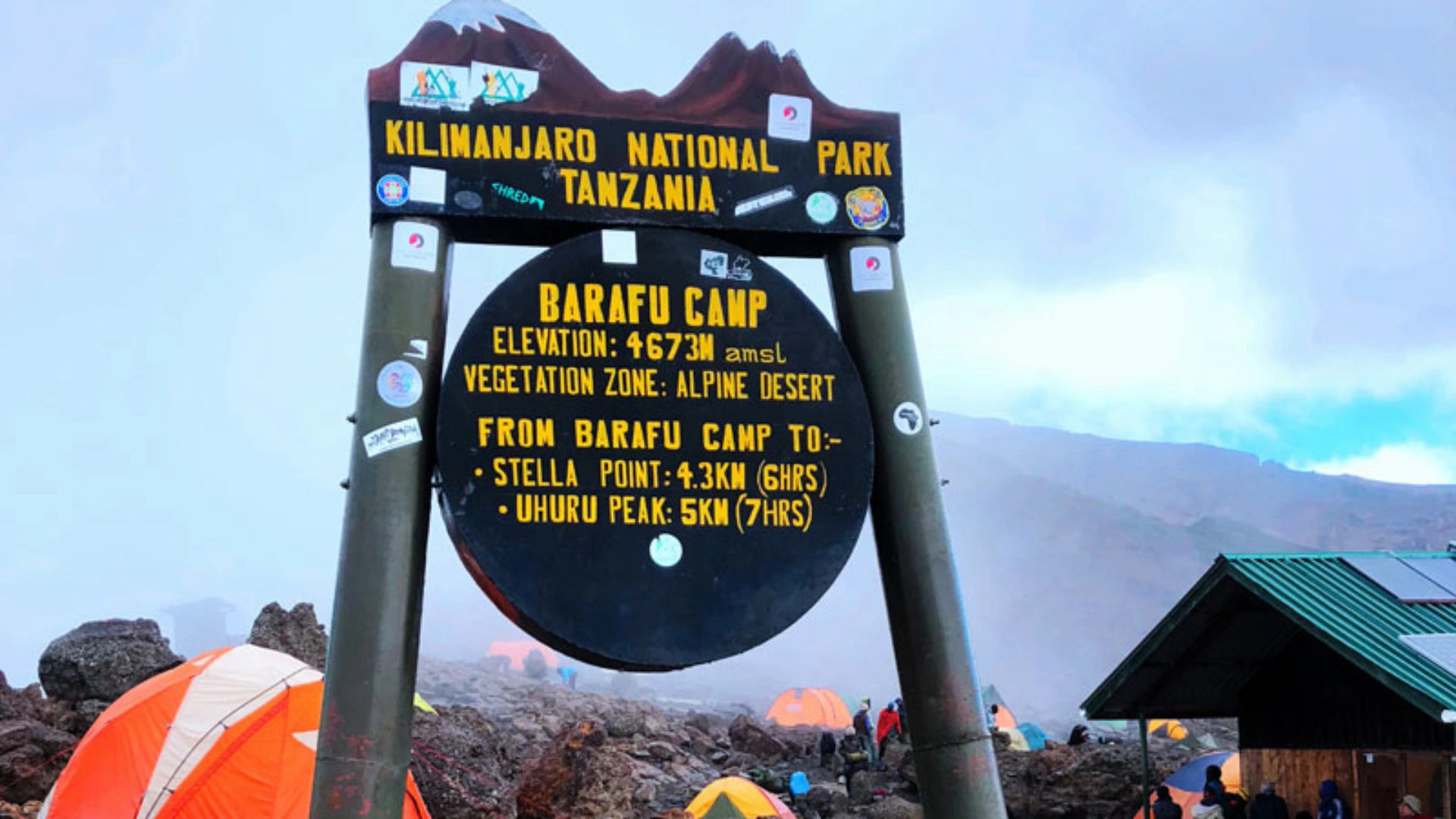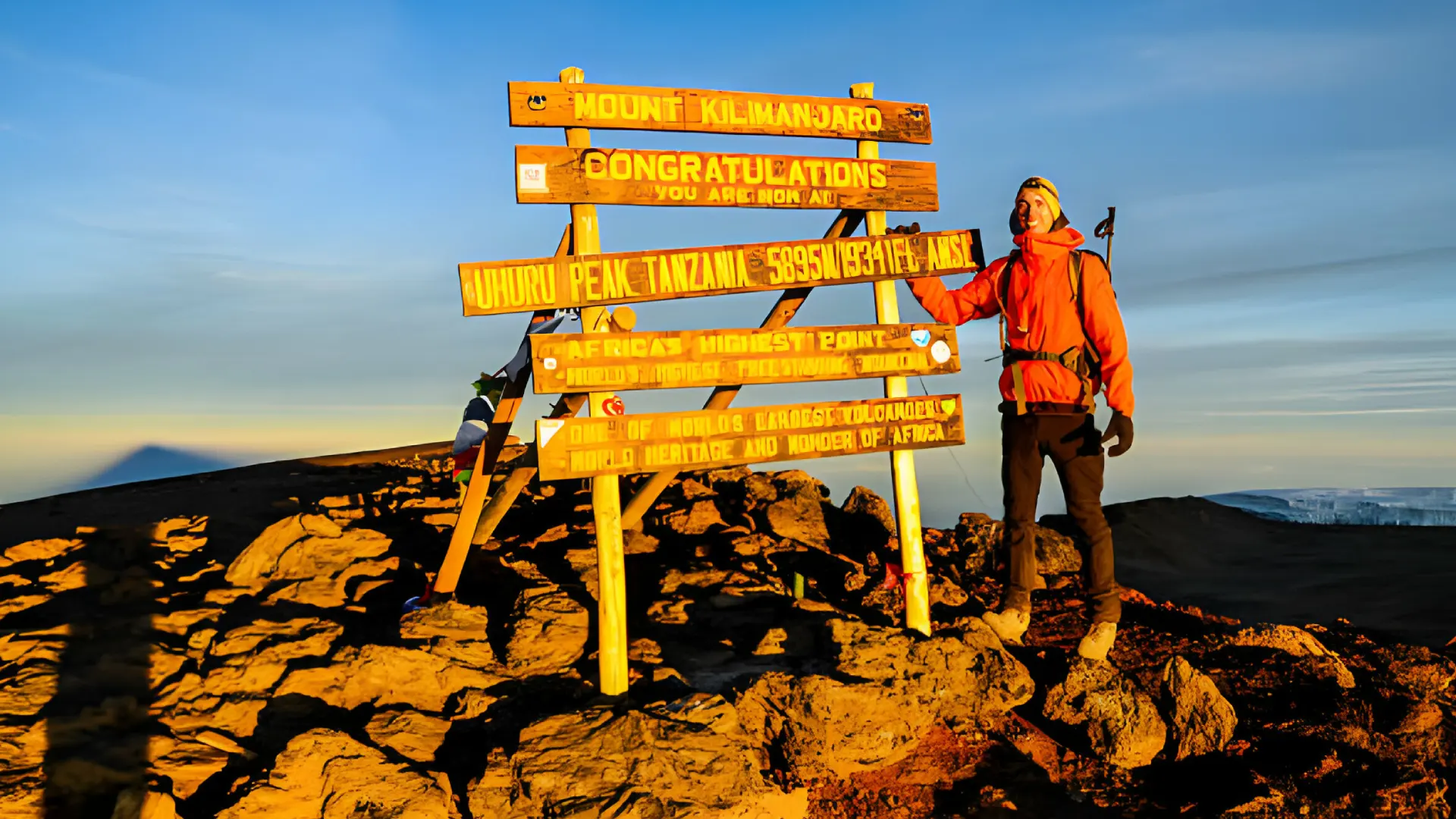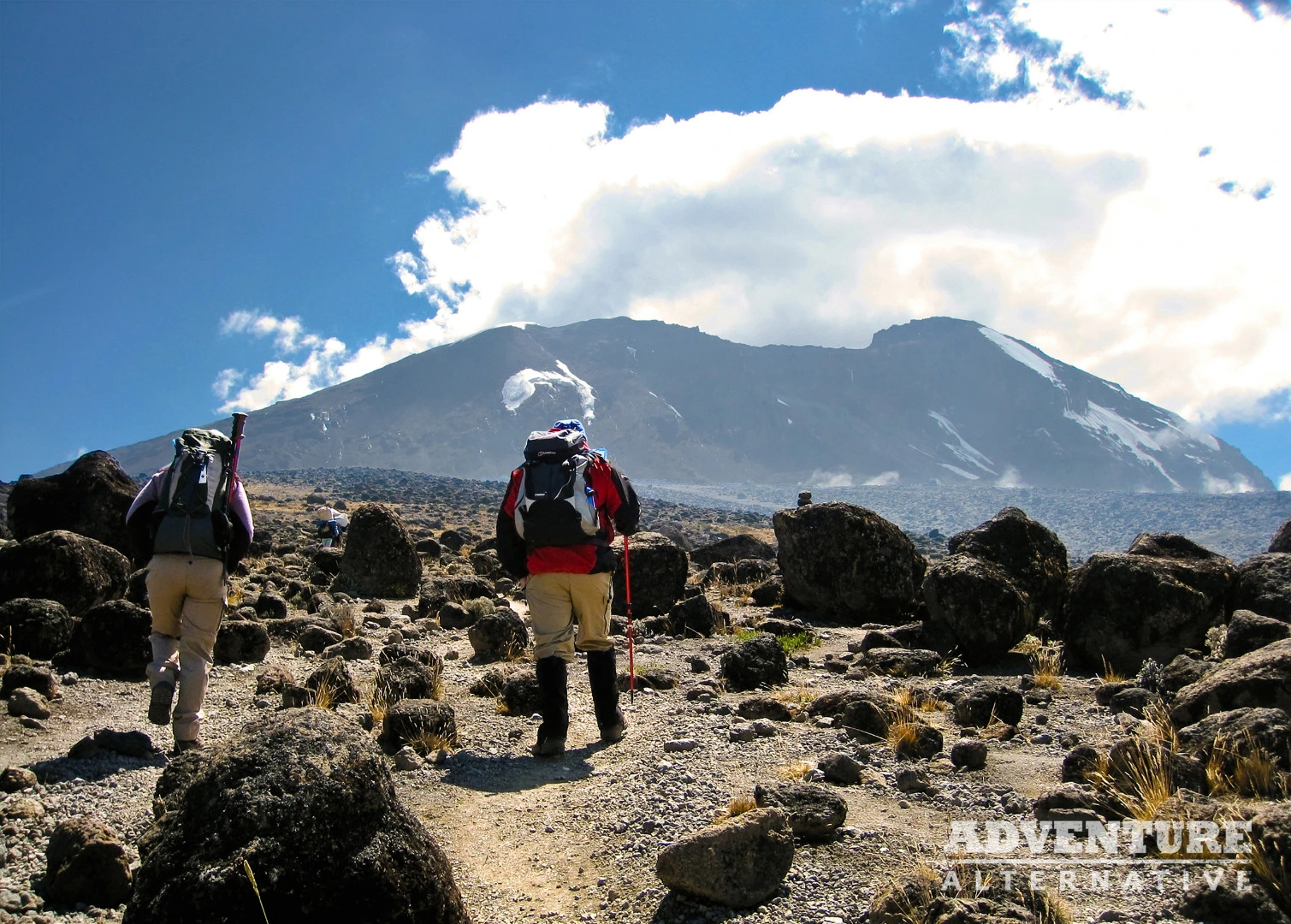7 Days Climbing Kilimanjaro Via Lemosho Route
The Kilimanjaro Northern Circuit Route is the newest and longest route, approaching from the west and offering stunning 360-degree mountain views.
- Duration: 7 days
- Difficulty: Moderate to Chalenging
- Price Per Person: $ 1,989- $ 2,053
- Scenery: very Good
Overview: Kilimanjaro Lemosho Route Trekking
Your journey to the highest point in Africa begins as you land at Kilimanjaro International Airport (JRO), where you’ll be greeted by your friendly guide and transferred to your hotel in either Moshi or Arusha. After settling in, take time to relax and rest, knowing that your adventure is about to unfold. This evening, you’ll attend a comprehensive pre-trek briefing where your expert guide will explain everything about the trek ahead—sharing the daily itinerary, providing tips for staying healthy, and discussing the importance of acclimatization, gear, and safety. Once briefed, you can rest easy, knowing you’re prepared for the incredible challenge ahead.
Trip Highlights
- Day 1: Lemosho Gate (2,100m) to Mti Mkubwa Camp (2,780m)
- Day 2: Mti Mkubwa Camp (2,780m) to Shira 2 Camp (3,850m)
- Day 3: Shira 2 Camp (3,850m) to Barranco Camp (3,960m)
- Day 4: Barranco Camp (3,960m) to Karanga Camp (4,035m)
- Day 5: Karanga Camp (4,035m) to Barafu Camp (4,640m)
- Day 6: Summit Day – Barafu Camp (4,640m) to Uhuru Peak (5,895m), Then Descend to Mweka Camp (3,080m)
- Day 7: Mweka Camp (3,080m) to Mweka Gate (1,640m) To the Hotel
What is Included
- Airport transfers (pick-up and drop-off)
- National park fees and camping fees
- Rescue fees
- Oxygen cylinders and first aid kit
- All meals while on the mountain
- Cleaned, Purified and drinking water
- Kilimanjaro summit certificate
- VAT (18% charged by government)
- Quality mess tents with table and chair
- Professional and experienced mountain guides
- All necessary trekking gear such as tents, sleeping bags, etc.
- Large portions of fresh, healthy and nutritious food
- Quality, waterproof, four-season mountain sleeping tents (on twin sharing basis)
What is not Included
- International and Domestic flights
- Travel insurance
- Personal items and gear (such as Clothing, trekking boots etc.)
- Soft drinks, alcohol or additional snacks
- Accommodation before and after trekking
- Tips and gratitude (senior guide $25 per day from the whole group, Assistant guide $20 per day for whole group, cooks $15 per day for whole group and Porters $10 per day from whole group.
Day 0: Arrival in Tanzania – Pre-Trek Briefing
Your journey begins with your arrival at Kilimanjaro International Airport, followed by a short transfer to your comfortable hotel. Here, you’ll have the opportunity to rest and begin to acclimatize to the atmosphere of Tanzania. In the evening, your guide will host a pre-trek briefing where you’ll learn about the Lemosho route, trekking techniques, and the exciting adventure that lies ahead.
Kilimanjaro Trekking Gallery
Day 1: Lemosho Gate (2,100m) to Mti Mkubwa Camp (2,780m)
The adventure truly begins after an early breakfast, when you’ll drive to the Lemosho Gate, situated at an altitude of 2,100 meters. The drive is a scenic journey through the countryside and lush forests, giving you a glimpse of the beauty surrounding Kilimanjaro. Upon arrival, the group will register at the gate before embarking on the hike through the vibrant rainforest. The path winds through dense foliage, home to a variety of bird species and unique plant life. The lush environment is an immersive experience that truly kicks off your climb.
As you ascend, you’ll notice the climate change as you move from the lowland forest to a slightly higher, cooler region. This first day of hiking covers about 6 km (4 miles), taking approximately 3 to 4 hours to reach Mti Mkubwa Camp (2,780m). With a modest elevation gain of +680m, this section is designed to ease your body into the challenge, offering a gentle introduction to the trek. The rainforest habitat will envelop you in its cool, damp atmosphere, with the sounds of nature accompanying you to the campsite.
Trekking Features
- Elevation Gain: +680m
- Distance: 6 km (4 miles)
- Hiking Time: 3-4 hours
- Habitat: Rainforest
- Meal Plan: Lunch and Dinner
- Overnight stay in tents
Day 2: Mti Mkubwa Camp (2,780m) to Shira 2 Camp (3,850m)
Day 2 offers another relatively short day, allowing your body to adapt further to the altitude while still advancing steadily toward the summit. After a good night’s rest, you’ll hike 6 km (3.7 miles) in about 4 to 5 hours toward Shira 2 Camp (3,850m). This segment of the trek is mostly flat, with the trail meandering across the Shira Plateau, providing you with mesmerizing views of the mountain and the surrounding wilderness. The volcanic landscape gives way to a more barren, rocky terrain that is characteristic of the alpine zone.
At +240m in elevation gain, the gradual increase is perfect for acclimatization. The camp is positioned in a beautiful location, surrounded by expansive views and panoramic vistas of the plateau. The cold night air will serve as a reminder that you’re nearing the summit, but with each passing day, you’ll grow stronger and more acclimatized to the altitude.
Trekking Features
- Elevation Gain: +240m
- Distance: 6 km (3.7 miles)
- Hiking Time: 4-5 hours
- Habitat: Moorland and Alpine Desert
- Meal Plan: Breakfast, Lunch and Dinner.
- Overnight stay in tents
Day 3: Shira 2 Camp (3,850m) to Barranco Camp (3,960m)
On Day 3, the trek becomes more challenging, as you ascend further into the highland terrain and traverse volcanic features like Lava Tower (4,630m). This day’s hike spans about 10 km (6 miles), with an estimated 6 to 7 hours of hiking. You will start by climbing to Lava Tower, where you’ll stop for acclimatization. This is a significant part of the trek, allowing your body to adjust to the higher altitude.
After Lava Tower, you’ll descend slightly to Barranco Camp (3,960m), a stunning site nestled at the base of the Barranco Wall, which you’ll tackle the next day. Despite the elevation gain of +110m, the altitude change will help your body continue acclimatizing while still advancing toward the summit. The terrain here is rocky and steep, and the alpine desert environment will feel more rugged and barren.
Trekking Features
- Elevation Gain: +110m
- Distance: 10 km (6 miles)
- Hiking Time: 6-7 hours
- Habitat: Alpine Desert
- Meal Plan: Breakfast, Lunch and Dinner.
- Overnight stay in tents
Day 4: Barranco Camp (3,960m) to Karanga Camp (4,035m)
Today is a thrilling day for climbers as you tackle the iconic Barranco Wall, a steep but short climb that offers spectacular views and a sense of achievement. The wall rises sharply, but it’s not technically difficult, and the route is well-defined. After reaching the top, you’ll continue for another 3 km (2 miles), reaching Karanga Camp (4,035m) after about 4 to 5 hours of hiking.
This section of the trek offers impressive views of the surrounding glaciers, and as you make your way to Karanga Camp, the environment begins to feel more barren and remote. With a modest elevation gain of +75m, the day provides another opportunity for acclimatization while still offering an unforgettable sense of progress.
Trekking Features
- Elevation Gain: +75m
- Distance: 5 km (3 miles)
- Hiking Time: 4-5 hours
- Habitat: Alpine Desert
- Meal Plan: Breakfast, Lunch and Dinner.
- Overnight stay in tents
Day 5: Karanga Camp (4,035m) to Barafu Camp (4,640m)
As you near the summit, your excitement builds. Day 7 is a relatively short but steady hike as you ascend to Barafu Camp (4,640m), situated at the base of the summit. This 4 km (2.5 miles) trek will take approximately 4-5 hours and will bring you across an increasingly barren alpine desert landscape.
Barafu Camp is where you’ll spend the night before your summit attempt. The air here is thinner, and the cold temperature will serve as a reminder of how high you’ve climbed. After a rest and a light meal, you’ll have the chance to prepare for your midnight summit attempt.
Trekking Features
- Elevation Gain: +605m
- Distance: 4 km (2.5 miles)
- Hiking Time: 4-5 hours
- Habitat: Alpine Desert
- Meal Plan: Breakfast, Lunch and Dinner.
- Overnight stay in tents
Day 6: Summit Day – Barafu Camp (4,640m) to Uhuru Peak (5,895m), Then Descend to Mweka Camp (3,080m)
This is the day you’ve been preparing for. You will rise around midnight and begin your ascent toward Uhuru Peak (5,895m), the highest point on the African continent. The trail is steep, and the air is thin, but with determination and perseverance, you’ll reach Stella Point (5,730m) before continuing to the summit. The final stretch to Uhuru Peak offers breathtaking views and a sense of accomplishment that’s hard to describe. After a brief time at the summit to take photos and celebrate, you’ll descend to Barafu Camp for a rest before continuing to Mweka Camp (3,080m) for the night.
The total hike today is long—about 12 km (7.5 miles)—and will take approximately 12-14 hours. This day is the most physically demanding, but it’s also the most rewarding as you stand on the rooftop of Africa.
Trekking Features
- Elevation Gain: +1,255m to the summit
- Distance: 12 km (7.5 miles)
- Hiking Time: 12-14 hours
- Habitat: Alpine Desert
- Meal Plan: Breakfast, Lunch and Dinner.
- Overnight stay in tents
Day 7: Mweka Camp (3,080m) to Mweka Gate (1,640m) To the Hotel
The final day is a descent through the lush rainforest back to the Mweka Gate. This is a relatively easy walk compared to the previous days, but it’s still a beautiful journey as you descend through thick vegetation and dense forest. The 10 km (6 miles) trek will take about 3 to 4 hours. Upon reaching the gate, you’ll receive your well-deserved summit certificate, marking the end of your incredible journey. A transfer will take you back to your hotel, where you can rest and reflect on your achievement.
Trekking Features
- Elevation Loss: -1,440m
- Distance: 10 km (6 miles)
- Hiking Time: 3-4 hours
- Habitat: Rainforest
- Meal Plan: Breakfast, Lunch and Dinner.
- Overnight stay in tents
Price Per Person
SEASON & DATES
2 pax
4 pax
6 pax
PRICE
Per Person
$1,989 USD*
$2,010 USD*
$2,053USD*
With high rate of 5-star review that rated with some of our travelers in our TripAdvisor and google platforms it gives us confident to inspire and persuade to make a trip in Tanzania with us, and you should visit both site and to see what others travelers Sayed about us.
our knowledgeable guides will share their passion for rich history, cultural, wildlife and uncover the hidden secrets of the African bush.
Experience a tailor-made Tanzania safari, meticulously crafted to match your unique desires and preferences. Discover breathtaking landscapes, vibrant wildlife, and unforgettable adventures, all designed exclusively for you.
we are licensed operator for this business in the tourism industry, with our quality service, and value of our product. We have obligation to abide by rules, face scrutiny and be accountable for everything we do and are held up to a high level of standards and practices. All travel deposits are held in a trust and protected for a security.
"Experience unforgettable wildlife encounters with us! Our expert-guided tours bring you closer to nature’s wonders, offering safe, responsible, and awe-inspiring adventures. Each safari is uniquely tailored to your preferences, ensuring a bespoke Tanzanian journey you’ll cherish forever."
Responsible tourism promotes sustainable practices, respecting local cultures, environments, and communities. It minimizes negative impacts, fosters economic benefits for locals, and encourages conservation efforts. Travelers make ethical choices, support local businesses, and protect natural and cultural heritage, ensuring destinations thrive for future generations while enriching their own travel experiences.
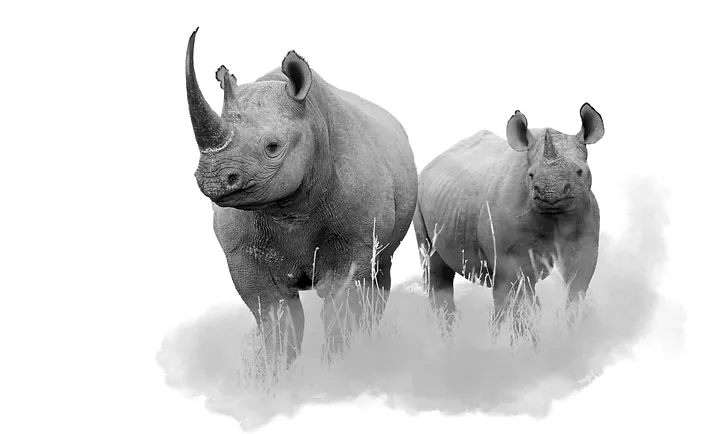
Where to Stay in Tanzania Safaris
When planning a Tanzanian safari, selecting the perfect accommodation ensures an unforgettable experience. Choose from luxury lodges, tented camps, and eco-friendly retreats, each offering unique comfort and proximity to nature, wildlife, and stunning landscapes. Tailor your stay to match your preferences, creating lasting memories amid Tanzania’s breathtaking beauty and adventure-filled settings.
The Lemosho Route is one of the most scenic and diverse routes to summit Mount Kilimanjaro. It starts on the western side of the mountain and traverses through lush rainforests, moorlands, alpine deserts, and the Shira Plateau before joining the Machame Route near the Lava Tower. The route typically takes 7-8 days to complete, allowing for excellent acclimatization and a high summit success rate. It is less crowded than other routes, offering a more remote and tranquil trekking experience.
The Lemosho Route is highly regarded for several reasons:
Scenic beauty: It offers stunning and varied landscapes, from rainforests to high-altitude deserts.
Excellent acclimatization: The longer duration (7-8 days) allows for a gradual ascent, reducing the risk of altitude sickness and increasing summit success rates.
Low traffic: The route is less crowded, especially in the early days, providing a more peaceful trekking experience.
High success rate: Due to its excellent acclimatization profile, the Lemosho Route has one of the highest summit success rates among all Kilimanjaro routes.
The Lemosho Route is considered moderately difficult. While it is longer and requires more days on the mountain, the gradual ascent makes it less physically demanding than steeper routes like the Umbwe or Machame routes. However, trekkers should still be prepared for long hiking days, varying weather conditions, and the challenges of high-altitude trekking. The route's excellent acclimatization profile makes it suitable for both beginners and experienced trekkers.
The Lemosho Route stands out for its:
Remote and pristine trails: The route starts on the less-visited western side of Kilimanjaro, offering a sense of solitude and untouched beauty.
Diverse landscapes: Trekkers pass through rainforests, moorlands, the Shira Plateau, and alpine deserts, providing a rich and varied experience.
High success rate: The route's longer duration and gradual ascent contribute to one of the highest summit success rates on the mountain.
Less crowded: Unlike popular routes like Marangu or Machame, the Lemosho Route sees fewer trekkers, especially in the early days.
The best time to trek the Lemosho Route is during the dry seasons, which are from late June to October and from December to early March. These periods offer stable weather conditions, clear skies, and minimal rainfall, making the trek more enjoyable and safer. While the Lemosho Route is less crowded year-round, trekking during the dry seasons ensures better visibility and more comfortable hiking conditions. Avoid the rainy seasons (April-May and November) as trails can become slippery and muddy.
Share your experience with Tanzania Songbirds Safaris on TripAdvisor! Your review helps us continue creating unforgettable adventures, from thrilling wildlife safaris and Zanzibar beach escapes to cultural and historical tours. Let fellow travelers know about your journey, and inspire others to explore Tanzania’s beauty. We value your feedback and can’t wait to hear from you!
Verified Incredible Experience Around Arusha City I was skeptical about this at the beginning but still decided to give it a chance. It was very positivity surprised by how nice my tour guide was, he picked me up from my hotel and took me around the city, he speak perfect English and made me feel safe throughout the whole trip. Honestly I cannot recommend this one enough, if you want to see this incredible city through the eyes of local. Thanks you so much Israel (my absolutely great tour guide for sharing this information and experience with me). It was definitely a day that will stay in my memory forever.Verified A fascinating walking tour of Arusha with a superb guide. We thoroughly enjoyed our walking tour of Arusha with Israel. He is extremely knowledgeable about the history and people of Arusha and Tanzania. He is also very flexible and responsive and we felt that we had an authentic experience of visiting the city, its markets and attractions. As important, it was great fun and Israel is a fabulous guide. Do not hesitate to book!Verified Great Experience Incredible experience, everything went well as planned, unforgettable experience and looking forward to do it again.Verified Interesting way to learn about Arusha Israel was our guide for this trip and was a very friendly, engaging and knowledgeable tour guide. He was also mindful of our small kids (7 and 12 years old) he make sure to make them enjoying the tour and give them the top priority and the kids they come to love so much Israel. Israel he took us to the difference places in the city that we didn't expect to visit but with him we done and make so much photos and with help of Israel we feel so comfortable to do that. Thank you again Israel!Verified Amazing guided tour by Israel Israel was a wonderful guide who taught me so much about the historic and cultural city of Arusha in the north region of Tanzania. I learned a lot of the German history at the museum, and then we visited multiple markets to learn about how the people live their daily lives. I would 100% recommend this tour to anyone looking to learn a little more about Arusha before or after their Safari.Verified Fantastic trip. Five star Fabulous- every day is a school day! I would recommend this trip for couples, friends, solo and family travellers. Christopher the guide is friendly, kind and extremely knowledgeable. He has a route planned but is flexible and generous with her time. We started at the top of the natural history museum. The group was small and there's was no pleasure on time.I recommend this trip for any tourist aroundVerified Highly recommend Arusha walking city tour! Christine was an amazing guide and demonstrated great knowledge to fulfill my understanding of the history of Arusha. The tour was designed well and we started by visit the natural history museum, Tanzaninite museum and shop, maasai market, local food market, cultural heritage and art gallery and I love so much the local street and food market and is one of the places without local guide is difficult to visit and to be comfortable.Christine was very friendly and maintained welfare of the groupVerified A lovely explore through Arusha with a friendly guide Wonderful tour we really felt like a friend, learning about the history of Arusha abd Tanzania too, abd taking routes around the city we would not have discovered! Israel was more than happy to give restaurant recommendations to us which went beyond the route he took us. Arusha is a nothing to see if you can't take a local guide to show you the city, (With great guide Israel we enjoyed the tour, feel safety walking in the street, visit different local areas, some tourist and some are not). Highly recommend to get your bearings and understand this beautiful city more!Verified I you only do one tour of Arusha make it this one I found this tour recommended by some of my friends who did this tour the time when spent in Tanzania and Arusha, the booking and communication with the operator was smooth and prompt. Our guide was assigned Israel as our guide and I can't thank him enough! Isra was super warm, accommodating and hilariously funny, but also extremely knowledgeable and engaging, which made a huge difference! It was awesome to hear him take on so many relevant topics related to Tanzanias fascinating recent history and development. I also thought the tour was extreme well curated, I interesting and also learning so much about Tanzania.Highly recommend!Verified Very Informative Walking Tour If you don't know where to start exploring Arusha, this tour is a must especially for the tourist like me you need to take this tour to get well see the city.Our guide Christine, was very well versed in the local history, traditions, culinary delights and points interest. She also speaks very good English and has an amazing uniquely Tanzania sense of humor.We enjoyed the 3 hour walk in Arusha and gave me more ideas as to what I want to explore further. Highly recommend
